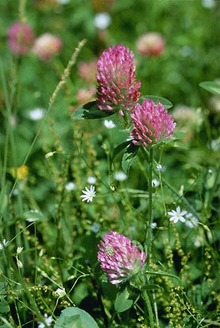Donna Foulk, Penn State Equine Natural Resources Educator is reminding horse owners that this is the time of year when animals sometimes ingest plants that can harm their health.

Red clover - May harbor Rhizoctonia fungus
It is not uncommon for some horses in a pasture to be more effected than others by slaframine found on clover, since horses vary in their preference for clover and sensitivity to the toxin.
Among the plants that commonly grow in pastures are both red and white clover and alfalfa. The plants themselves are not toxic. The toxin, slaframine, is produced by the Rhizoctonia fungus which grows on clovers and alfalfa during periods of stress when humidity is high, drought onditions exist and continuous grazing weakens the plants.
White clover is a very common legume that is frequently found in pastures. It can grow if soil fertility is poor, and will survive close grazing. It is a short lived perennial, and is a prolific seed producer. Although individual plants do not live very long, new plants are constantly being produced from seed.
It has no upright stems, and spreads by stolons. Stolons are stems that run along the surface of the ground, and produce new plants. The plant has compound leaves with three leaflets, and a white “V” on each leaflet. Flowers are white in color.
Red clover is a short lived perennial that has an erect growth habit. The plant has reddish purple flowers at the end of each stem. Stems are hairy. Red clover is also a common pasture legume. Since it does not tolerate continuous grazing, it is not normally found in overgrazed pastures.
Hay made from contaminated forages is also suspect, and the slaframine can remain in hay for several years. It is not uncommon for some horses in a pasture to be more effected than others, since horses vary in their preference for clover and sensitivity to the toxin.
Symptoms of horses affected by Rhizoctonia fungus
The slaframine stimulates the salivary glands and causes horses to drool. Although this is a nuisance, horses rarely suffer any health effects from grazing infected clover. Other symptoms occasionally include tearing, skin lesions, difficulty breathing, increased urination and feed refusal.
Management of Rhizoctonia
- Remove horses from infected pastures.
- Mow pastures until the brown fungal spots are no longer present on the leaves.
- Increase the concentration of grass by over-seeding pastures and applying nitrogen fertilizer in spring and fall.
- Rest and rotate pastures to allow the grass to remain tall and competitive with the clover.
- Broad leaf herbicides, labeled for pasture use, can be used to remove existing clover plants from pastures.
By taking preventative measures, horses can be protected from plants that might cause colic, health problems or death.
County agents often have lists of toxic plants in their area available either on line or through email requests.
